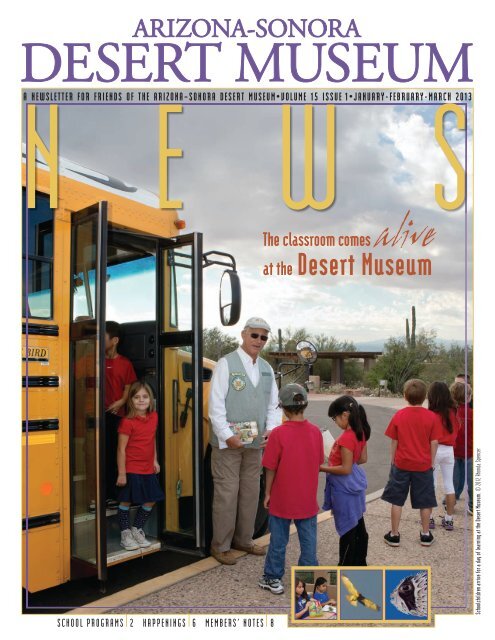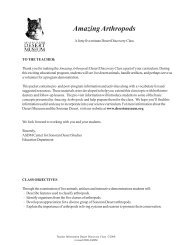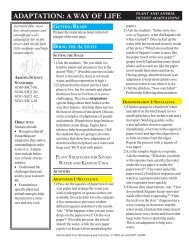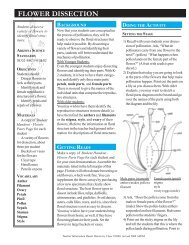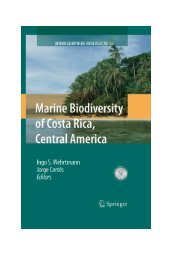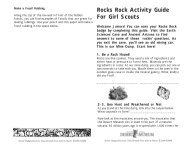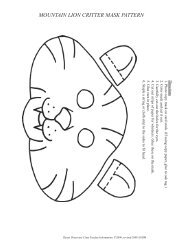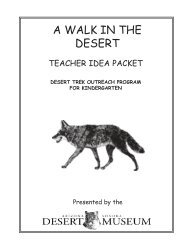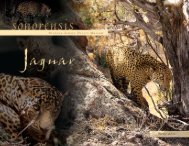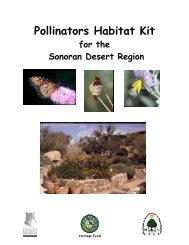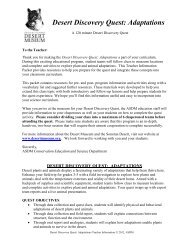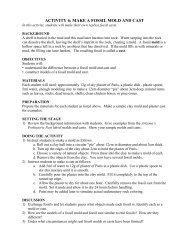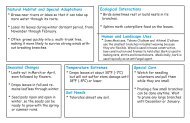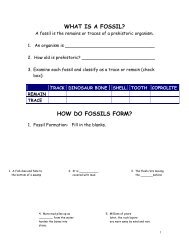January-February-March 2013 - Arizona-Sonora Desert Museum
January-February-March 2013 - Arizona-Sonora Desert Museum
January-February-March 2013 - Arizona-Sonora Desert Museum
Create successful ePaper yourself
Turn your PDF publications into a flip-book with our unique Google optimized e-Paper software.
NA NEWSLETTER FOR FRIENDS OF THE EARIZONA–SONORA DESERT MUSEUM•VOLUME W15 ISSUE 1•JANUARY-FEBRUARY-MARCH S<strong>2013</strong><br />
alive<br />
The classroom comes<br />
at the <strong>Desert</strong> <strong>Museum</strong><br />
SCHOOL PROGRAMS 2 HAPPENINGS 6 MEMBERS’ NOTES 8<br />
Schoolchildren arrive for a day of learning at the <strong>Desert</strong> <strong>Museum</strong>. © 2012 Rhonda Spencer
“I have taken<br />
my class to the desert<br />
museum for 9 years and it<br />
has always been my favorite<br />
field trip. “<br />
—Teacher<br />
Copperview Elementary<br />
The <strong>Desert</strong> <strong>Museum</strong><br />
is a Living Classroom<br />
By Debra Colodner, Ph.D., Director of Conservation Education and Science<br />
School groups. © 2012 Rhonda Spencer<br />
Take a moment to think<br />
back to your elementary<br />
school days.<br />
Can you remember anything about<br />
the first day of third grade? How about<br />
fourth or fifth? Any memorable lessons<br />
or projects from second grade? Okay,<br />
how about a school field trip?<br />
My guess is that you can remember<br />
at least one of those trips pretty vividly.<br />
Whether it was a tour of the zoo, the<br />
local fire station, or an arts performance,<br />
most people can remember<br />
something they experienced or learned<br />
during a school field trip. The fun and<br />
excitement of a day away from the typical<br />
classroom environment help these<br />
memories last into adulthood.<br />
It’s the ultimate field trip.<br />
About 20,000 school children visit<br />
the <strong>Desert</strong> <strong>Museum</strong> with their classes<br />
each year. For the <strong>Museum</strong>, that’s<br />
20,000 chances to inspire wonder and<br />
learning about the <strong>Sonora</strong>n <strong>Desert</strong>.<br />
For the students, it’s a chance to be<br />
outdoors with their friends and see<br />
animals and desert plants. For teachers,<br />
it’s a chance to bring science concepts<br />
alive. Teachers come with varied learning<br />
goals for their students, depending<br />
on what subject they teach, where they<br />
are in their curriculum, and their own<br />
teaching philosophy. Some teachers ask<br />
students to pay attention to structure<br />
and function in the way plants and animals<br />
are put together. Some emphasize<br />
the differences and similarities among<br />
mammals, birds, reptiles, etc., and ask<br />
students to notice differences in the<br />
various habitats at the <strong>Desert</strong> <strong>Museum</strong>.<br />
Others use the field trip as an experience<br />
to reinforce or practice writing, art, math,<br />
or a host of assorted science topics.<br />
Nature inspires learning.<br />
The <strong>Desert</strong> <strong>Museum</strong> is a great place<br />
to make observations about nature<br />
that spark questions and further learning.<br />
The close proximity of simulated<br />
regional biotic communities, including<br />
a mountain woodland, a grassland, a<br />
desert, and a riparian zone, is a perfect<br />
laboratory for comparing and contrasting<br />
the adaptations of and ecological<br />
relationships among plants and animals<br />
in each habitat.<br />
Over the last two years, with funding<br />
from the Nina Mason Pulliam<br />
Charitable Trust and the JP Morgan-<br />
Chase Foundation, <strong>Museum</strong> education<br />
specialists have worked with local<br />
teachers to revise the activity guides we<br />
provide for school visits.<br />
Third to fifth grade students can<br />
now participate in a Quest, a thematic<br />
treasure hunt to learn about desert<br />
“Students<br />
will make observations<br />
and other scientific<br />
entries (label pictures,<br />
draw diagrams, observe, predict,<br />
make connections, etc.) in<br />
their science notebooks.”<br />
—Teacher<br />
Laguna Elementary<br />
2 www.desertmuseum.org
adaptations. Armed with a backpack of<br />
supplies and scientific equipment, student<br />
teams follow clues to various museum<br />
locations and complete activities that<br />
explore plant and animal adaptations.<br />
Each Quest wraps up with team reports<br />
and a live animal presentation. During<br />
their Quest, students use observation,<br />
critical thinking, and investigative skills.<br />
In the new sixth and seventh grade<br />
activity guides, students become<br />
“experts” on specific biotic communities<br />
displayed at the <strong>Desert</strong> <strong>Museum</strong>,<br />
learn about the diversity and food<br />
webs within each community, then<br />
report to their peers about what they<br />
have learned. The guides are not only<br />
aligned with the current life science<br />
academic standards, but address the<br />
coming science and common core<br />
standards as well by asking students to<br />
write and present within the science<br />
discipline, analyze systems, and engage<br />
in argument from evidence.<br />
While at the <strong>Museum</strong>, teachers can<br />
also choose to have their students participate<br />
in one of 20 different classes<br />
and labs, on everything from reptiles to<br />
rocks and minerals. Before or after they<br />
visit, students can also prepare or review<br />
using some of the online games on the<br />
<strong>Museum</strong>’s website: (www.desertmuseumdigitallibrary.org/kids/Games.html),<br />
including a Food Web Game, <strong>Desert</strong><br />
Adaptations Game, <strong>Desert</strong> Zoodoku, and<br />
Seek and Find. They can also do research<br />
using the <strong>Museum</strong>’s digital library.<br />
Making it happen<br />
one busload at a time.<br />
Getting 20,000 students to<br />
the <strong>Desert</strong> <strong>Museum</strong> is no small<br />
feat. School buses, school budgets,<br />
and demands on teachers<br />
are more constraining than ever.<br />
Transporting and coordinating<br />
activities for this large number of<br />
young visitors is a tribute to dedicated<br />
teachers who jump over unimaginable<br />
hurdles to plan the trips and devoted<br />
parents who are commonly asked<br />
to foot the bill. It is also a tribute to<br />
a number of foundations that have<br />
underwritten school admissions at the<br />
<strong>Desert</strong> <strong>Museum</strong> over the last several<br />
years, most notably the Bert W. Martin<br />
Foundation, the Stonewall Foundation,<br />
the Nina Mason Pulliam Charitable<br />
Trust, and the JP Morgan-Chase<br />
Foundation.<br />
Teachers continue to attest to the<br />
value of a <strong>Desert</strong> <strong>Museum</strong> field trip.<br />
They tell us that in addition to the<br />
science learning, they appreciate the<br />
opportunity to expose students to the<br />
beauty and wonder of the <strong>Sonora</strong>n<br />
<strong>Desert</strong>. For many students, their school<br />
field trip is the first time they have the<br />
chance to visit the <strong>Desert</strong> <strong>Museum</strong>,<br />
and for some, it is their first time outside<br />
of the city. These early experiences<br />
in nature are extremely important for<br />
developing an attitude of environmental<br />
stewardship later in life.<br />
“Our<br />
second graders<br />
had such a wonderful<br />
time at the <strong>Desert</strong> <strong>Museum</strong><br />
today! We have done some of<br />
the online activities through<br />
your website and will be doing<br />
more this week.”<br />
—Teacher<br />
Ford Elementary<br />
School groups. © 2012 Rhonda Spencer<br />
Food Web game (www.desertmuseumdigitallibrary.org/kids/Games.html)<br />
Student photographs habitat with her digital tablet. © 2012 Rhonda Spencer<br />
Did you visit the <strong>Desert</strong> <strong>Museum</strong> on a school field trip?<br />
Share your field trip memories of the <strong>Desert</strong> <strong>Museum</strong> at facebook.com/desertmuseum.<br />
www.desertmuseum.org 3
“Thank You!<br />
Your gifts sustain the vision of the <strong>Desert</strong> M<br />
and old and by inspiring all to fall in love<br />
MAJOR GIFTS<br />
Mr. and Mrs. Paul L. Baker<br />
Priscilla & Michael Baldwin Foundation, Inc.<br />
Mr. and Mrs. Archibald M. Brown<br />
Estate of Elizabeth Ann Dunseth<br />
Estate of Elizabeth Mayer<br />
The Stonewall Foundation<br />
MEMORIAL GIFTS<br />
In memory of<br />
Mr. and Mrs. Marshall Becker<br />
Mr. and Mrs. Stuart A. Berman<br />
Ms. Barbara Levinson<br />
In memory of Jesse Stuart Carlson<br />
Mr. and Mrs. Alan Moore<br />
Mrs. Shirley B. Moore<br />
In memory of Mary Davidson<br />
Ms. Beth Hand<br />
In memory of Adele Domont<br />
Mark & Cathy Stanley<br />
In memory of Mr. Peter Duerr<br />
Joe and Barbara Cornell<br />
Mr. Todd Katzner<br />
Ms. Sarah Kennedy<br />
Mr. and Mrs. Gail Skinner<br />
In memory of Miriam Clark Fletcher<br />
Anonymous<br />
In memory of<br />
Mr. Walter G. Henderson<br />
Ms. Mary Morris<br />
In memory of Janice Hoff<br />
Mr. and Mrs. Robert Friederich<br />
In memory of Mrs. Annie M. Kuberek<br />
Mr. William D. Monk<br />
Mr. and Mrs. James J. Schnitzer<br />
In memory of Mrs. Susan Lawes<br />
Ms. Susan Sullivan<br />
In memory of Mrs. Jody Luther<br />
Ms. Sarah Linderman<br />
In memory of Mrs. Susan Martin<br />
Ms. Carol M. Cochran<br />
In memory of Reva Z. Sherman<br />
NNSA<br />
Contracts & Procurement Division<br />
Mr. and Mrs. Marty Shainen<br />
In memory of Anne Williams<br />
Mr. Robert J. Lathlaen<br />
For information about gifts contact Brian Bateman,<br />
Executive Philanthropy Director, 520/883-3003<br />
Corrections:<br />
In memory of<br />
Arnold I. Hollander, M.D.<br />
Mr. and Mrs. Charles J. Erickson<br />
In memory of<br />
Mr. Frederick A. Jacobson, IV<br />
The Jacobson Family<br />
HONORARIUMS<br />
In honor of<br />
Virginia W. Ames & Martha A. Burgess<br />
Mr. George E. Price & Ms. Shirin D. Antia<br />
In honor of Mr. Jesus M. Garcia<br />
and Ms. Sonya Norman<br />
ASDM’s Spain Trip Participants<br />
In honor of the birthday of<br />
Mrs. Deborah Howard Jacob<br />
Mr. and Mrs. Christopher Mathis<br />
In honor of the 90th birthday of<br />
Mrs. Marcille Lynn<br />
Ms. Jan R. Bell<br />
In honor of Mrs. Phyllis Wassenberg<br />
Mr. Chris Wassenberg<br />
The mission of the <strong>Arizona</strong>-<strong>Sonora</strong> <strong>Desert</strong> <strong>Museum</strong><br />
is to inspire people to live in harmony with the natural world<br />
by fostering love, appreciation, and understanding of the <strong>Sonora</strong>n <strong>Desert</strong>.<br />
Like lots of Tucson kids,<br />
the <strong>Desert</strong> <strong>Museum</strong> was central to Rick Small’s life.<br />
Now as president of the Stonewall Foundation he has become pivotal to the growth and vitality<br />
of the <strong>Museum</strong>! Established in 1987 as a Community Support Organization, the Stonewall<br />
Foundation has invested nearly $800,000 in the <strong>Museum</strong>. “Early on we tended to choose projects<br />
like a sculpture, the aviary or hummingbird exhibit, but a decade ago we moved to educational<br />
programming realizing the impact we could make on children in the region,” according<br />
to Rick. The Amigos del Desierto program, funded by the Stonewall Foundation, has served<br />
21 schools and more than 10,000 children over the years. The “Amigos” program targets low<br />
income schools with a high proportion of English language learners and helps these students<br />
develop a love and appreciation for their <strong>Sonora</strong>n <strong>Desert</strong> home. Each year, the <strong>Museum</strong> partners with a school to develop<br />
a year-long collaboration customized to the school’s needs. The partnership usually includes multiple classes for all the students,<br />
professional development sessions with teachers, field trips to the <strong>Museum</strong> for students, teachers and families, and a<br />
special project, like developing a school garden, a tortoise habitat or overnight camping trips. Thank you to Rick Small and<br />
the Stonewall Foundation for making such an impact on young students.<br />
4 www.desertmuseum.org
useum by educating citizens young<br />
with nature and care for the earth.<br />
“<br />
Giving Back to Mother Nature<br />
By Brian Bateman, Executive Philanthropy Director<br />
Elizabeth “Betty” Mayer<br />
died just hours before<br />
midnight on June 23, 2012<br />
—her 84th birthday.<br />
Her death ended her valiant battle<br />
against the cancer that kept her homebound<br />
for nearly two years. Before<br />
her death, Betty made it clear that<br />
she wanted to give back to Mother<br />
Nature. In her case that meant that half<br />
of her life savings was to be invested<br />
in the most vital needs of the <strong>Desert</strong><br />
<strong>Museum</strong>.<br />
“The first thing you need to know<br />
about Betty,” according to Joan Booth,<br />
her friend and trustee, “is that she<br />
started from nothing. Everything she<br />
earned, she saved and carefully invested.”<br />
For the 40 years she lived in<br />
Tucson, the <strong>Museum</strong> provided a<br />
unique and wonderful place for Betty<br />
to share her Southwest home with family<br />
and friends. She was highly attuned<br />
to nature and held deep convictions<br />
about preserving wildlife and plants.<br />
Born to German immigrant parents<br />
in Weehawken, New Jersey, Betty’s<br />
father left the family when she was<br />
very young. Following the death of<br />
her mother, she moved to Michigan to<br />
live with her half-brother at the age of<br />
14. She enrolled at the University of<br />
Michigan on an active duty Air Force<br />
scholarship where she completed her<br />
bachelor’s degree in business after her<br />
tour of duty in Germany.<br />
She reached the rank of Lt. Col with<br />
22 years of active duty before retiring<br />
from her post at Westover Air Force<br />
Base in Massachusetts, where she met<br />
Joan Booth. The two of them moved<br />
to Tucson in 1972 where they enrolled<br />
in real estate school. Joan pursued a<br />
20-year career selling homes. Betty, on<br />
the other hand, sold just one home,<br />
decided she did not like it, and spent<br />
her time volunteering for a number of<br />
non-profit organizations.<br />
“Betty was a quiet, very neat person,<br />
and she loved to read. She enjoyed<br />
travel but, in particular, she loved to<br />
show off the <strong>Museum</strong> to her Tucson<br />
visitors,” according to Joan. “They<br />
would arrive in the morning when the<br />
gates first opened, explore all the exhibits,<br />
and then take a picnic lunch to<br />
enjoy at the nearby grounds.”<br />
Her financial advisor, Carl<br />
Stauss, says, “Betty was a careful<br />
steward of her financial<br />
resources and also greatly appreciated<br />
those, like her, who were<br />
stewards of the environment.<br />
She always spoke highly of the<br />
<strong>Desert</strong> <strong>Museum</strong> as an important<br />
guardian of our <strong>Sonora</strong>n <strong>Desert</strong>.<br />
I feel very fortunate to have<br />
known Betty, and with each visit<br />
to the <strong>Desert</strong> <strong>Museum</strong>, I will<br />
remember Betty giving back to<br />
Mother Nature.”<br />
Introducing<br />
the <strong>Desert</strong> <strong>Museum</strong>’s<br />
Research & Conservation Team<br />
The <strong>Museum</strong>’s research and<br />
conservation staff has<br />
welcomed some new talent,<br />
and the team is focused on various<br />
research and conservation efforts<br />
important to the <strong>Sonora</strong>n <strong>Desert</strong><br />
region. Read more about their research<br />
at desertmuseum.org.<br />
Clare Aslan, Ph.D.<br />
Conservation Research Scientist<br />
Clare grew up in <strong>Arizona</strong>, and<br />
says she is thrilled to be back in Tucson<br />
doing research in the Chiricahuas,<br />
White Mountains, and Gulf of<br />
California islands. Her focus is the<br />
ecosystems of the <strong>Sonora</strong>n <strong>Desert</strong>, and<br />
specifically the effect of environmental<br />
change on pollination and seed<br />
dispersal. Clare joins us after recently<br />
completing her David H. Smith<br />
Conservation Postdoctoral Fellowship<br />
at UC Santa Cruz, California, and in<br />
Hawaii.<br />
Kimberly Franklin, Ph.D.<br />
Conservation Research Biologist<br />
Kim is a scientist immersed in<br />
both the theoretical and<br />
practical aspects of biodiversity.<br />
Her studies include ecological processes<br />
that generate spatial variation in species<br />
(Continued Page 7)<br />
(L to R) Karen Krebbs, Kim Frnaklin, Clare Aslan © ASDM, Sloane Haywood<br />
www.desertmuseum.org 5
“Here Today...” (Detail) Sea of Cortez Exhibit. © 2012 Kim Duffek 60 carat Brazilian Aquamarine atop Beryl. © 2009 Jeanne Broome Gala <strong>2013</strong> raffle sculpture by Mark Rossi. © 2012 David Scott Allen<br />
RAPTOR FREE FLIGHT<br />
Now through Sunday, April 14<br />
10 a.m. and 2 p.m. daily<br />
This exciting program soars again in the<br />
<strong>Arizona</strong> Uplands. Come see a group of<br />
ravens, hawks, owls, roadrunners, and<br />
falcons as you could never see them in the<br />
wild — up close!<br />
MINERAL MADNESS<br />
MINERAL SALE AND FAMILY FUN!<br />
Saturday, <strong>January</strong> 19 – Sunday, <strong>January</strong> 20<br />
Baldwin Education Building<br />
Open 9 a.m. – 4 p.m.<br />
The Mineral Madness event at the <strong>Desert</strong><br />
<strong>Museum</strong> is a chance for everyone, from<br />
the novice to the serious collector, to learn<br />
something new about minerals and rocks,<br />
and to find new treasures for their collections.<br />
Activities include a mineral sale with<br />
thousands of specimens, affordably priced.<br />
Learning stations throughout the <strong>Museum</strong><br />
grounds will be open from 11 a.m. – 4<br />
p.m. each day, including “Painting with<br />
Minerals” with the <strong>Museum</strong>’s Art Institute.<br />
At each station, children can collect a free<br />
mineral specimen. Children should bring an<br />
egg carton for their collection, if possible.<br />
EXHIBIT<br />
HOWARD PALEY FIRST IMPRESSIONS<br />
<strong>January</strong> 19 – <strong>March</strong> 3, 10 a.m. – 4 p.m.<br />
Opening Reception: Saturday, <strong>January</strong> 19<br />
2 – 4 p.m., Baldwin Gallery<br />
Artist Lecture: <strong>January</strong> 19, 1:30 – 2:00 p.m.<br />
Warden Oasis Theater<br />
ASDM<br />
Happenings<br />
RAFFLE DRAWING<br />
FOR THE 20TH ANNUAL DESERT GALA<br />
Buy your raffle ticket today to win a sculpture by noted Tucson sculptor Mark Rossi.<br />
This year’s bronze sculpture depicts the <strong>Desert</strong> <strong>Museum</strong>’s icon, a mountain lion. The drawing will<br />
occur at the Gala on Sunday, April 28. You need not be present to win. Proceeds support<br />
education, research, and conservation programs at the <strong>Desert</strong> <strong>Museum</strong>. Tickets are $20<br />
each. To purchase tickets visit desertmuseum.org or call 520/883-3055.<br />
EXHIBIT<br />
WOMEN POTTERS OF MATA ORTIZ<br />
<strong>January</strong> 26 – <strong>February</strong> 3<br />
Opening Reception: <strong>January</strong> 25, 5 – 8 p.m.<br />
Baldwin Education Building<br />
Open 10 a.m. – 5 p.m.<br />
Join the celebration the women potters<br />
of Mata Ortiz! Over 230 women potters,<br />
from young girls to their grandmothers,<br />
were interviewed, and 150 were selected to<br />
showcase their pottery. Meet these amazing<br />
women, view demonstrations, and<br />
purchase their works of art.<br />
EXHIBIT<br />
ART INSTITUTE STUDENT SHOW<br />
<strong>February</strong> 9 – <strong>March</strong> 9<br />
Opening Reception: <strong>February</strong> 16, 2 – 4 p.m.<br />
Ironwood Gallery, open 10 a.m. – 4 p.m.<br />
12TH ANNUAL MEMBERS’<br />
VALENTINE’S DAY DINNER<br />
Thursday, <strong>February</strong> 14, 6 – 9 p.m.<br />
Ironwood Restaurant Complex<br />
Save the date!<br />
COPPER, SILVER, GOLD & LIFE<br />
MEMBERS — A Tour of the Warden<br />
Aquarium – Rivers to the Sea!<br />
Thursday, <strong>March</strong> 14, 4 – 6 p.m.<br />
Save the date!<br />
6 www.desertmuseum.org<br />
COATI PUPS PROGRAMS<br />
Coati Pups Preschool and Toddler<br />
Programs are for children ages 2 – 5 who<br />
are wild about the desert. All programs<br />
include on-grounds exploration, live animal<br />
encounters, a snack, and a craft your child<br />
can take home. For program dates, information,<br />
and registration, see desertmuseum.org/kids/<br />
toddlers or call 520/883-3025.<br />
MUSEUM EXPLORERS CAMPS<br />
Fox Camp: Entering grades 1 and 2<br />
Bobcat Camp: Entering grades 3 – 4<br />
<strong>Desert</strong> and Sea Camp: Entering grades 5 – 6<br />
Two Sessions (Monday – Thursday)<br />
July 22 – 25 and July 29 – August 1,<br />
8:30 a.m. – 3 p.m.<br />
Aftercare available from 3 – 5 p.m.<br />
Hands-on, minds-on day camps will open<br />
young eyes to the wonders of the <strong>Sonora</strong>n<br />
<strong>Desert</strong> Region. <strong>Museum</strong> Explorers observe<br />
live animals up-close, conduct science experiments,<br />
sample desert foods, hike in the<br />
desert, create desert art with the <strong>Museum</strong>’s<br />
Art Institute, and visit animals behind-thescenes.<br />
Information and online registration<br />
at desertmuseum.org/kids/camp.<br />
EARTH CAMPS FOR MIDDLE AND<br />
HIGH SCHOOL STUDENTS<br />
Middle School Dates: June 17 – 24 and 24 – 28<br />
High School Dates: July 6 – 17<br />
Application Deadline: <strong>March</strong> 15<br />
Earth Camp focuses on this awe-inspiring<br />
planet, drawing connections from our<br />
homes, to our region, to the globe, and<br />
to what we can learn about Earth from<br />
space. Middle School Earth Camp is a day<br />
camp, with three camping overnights in<br />
the deserts and mountains of our region.<br />
High School Earth Camp is a 12-day field<br />
excursion, including a five-day wilderness<br />
rafting trip on the Green River in Eastern<br />
Utah. Earth Camp is a collaboration<br />
with the University of <strong>Arizona</strong>, Planetary<br />
Science Institute, and the <strong>Desert</strong> <strong>Museum</strong>.<br />
Full and partial scholarships are available<br />
via funding from NASA, JP Morgan Chase<br />
Foundation and private donors. For information<br />
visit desertmuseum.org/earthcamp.<br />
EXHIBIT<br />
THE SEA OF CORTEZ<br />
<strong>March</strong> 16 – June 2, 10 a.m. – 4 p.m.<br />
Opening reception: Saturday, <strong>March</strong> 16<br />
2 – 4 p.m., Ironwood Gallery<br />
The Sea of Cortez and its surrounding<br />
landmass have long been a favorite place<br />
for scientific study and conservation efforts<br />
on behalf of the <strong>Desert</strong> <strong>Museum</strong>. In 2011,<br />
30 professional artists traveled to San<br />
Carlos, <strong>Sonora</strong>, to sketch, paint, and photograph<br />
the unusual terrain of Nacapule,<br />
the Estero Soldado, and the beautiful Sea<br />
of Cortez. Enjoy their artistic journey.
Adult Classes and Trips<br />
Registration Information: Go to desertmuseum.org/adultclasses or call 520/883-<br />
3086. Prices are for ASDM members. Add 10% for non-members.<br />
(Continued from page 5)<br />
The <strong>Desert</strong> <strong>Museum</strong>’s<br />
Research & Conservation Team<br />
CLASSES<br />
SANDHILL CRANES, RAPTORS,<br />
AND WATERFOWL<br />
<strong>January</strong> 31<br />
Thousands of cranes migrate from as far<br />
away as Alaska to winter in the desert<br />
grasslands and agricultural ponds near<br />
Willcox. $70<br />
MOUNTAINS, MINES, & MINERALS<br />
<strong>February</strong> 16<br />
Visit an old mining site and learn to identify<br />
malachite, pyrite, garnet, and other minerals<br />
that you find. $70<br />
MAMMOTHS OF THE SAN PEDRO<br />
VALLEY<br />
<strong>March</strong> 9<br />
Visit a mammoth kill site and learn about<br />
the Clovis Culture, see fossils of the megafauna<br />
that roamed <strong>Arizona</strong> 10,000 years<br />
ago, and collect gypsum crystals. $70<br />
WILDFLOWER WALKS<br />
<strong>March</strong> 13 or 16<br />
Join this leisurely hike into a canyon in the<br />
Tucson Mountains to see colorful desert<br />
flora. $36<br />
LANDSCAPING WITH CACTI<br />
& SUCCULENTS<br />
<strong>March</strong> 24<br />
Learn how and why people use spiny<br />
plants. The class will focus on irrigation,<br />
selection, planting, propagation, pest control,<br />
and fertilizing. $36<br />
CHOLLA BUD HARVEST<br />
April 6<br />
Participate in the centuries-old <strong>Sonora</strong>n<br />
<strong>Desert</strong> springtime ritual of collecting and<br />
preparing cholla buds. Learn about other<br />
versatile desert foods such as the nopal.<br />
$65<br />
HUMMINGBIRDS<br />
April 11 and 13<br />
Hummingbirds, the smallest<br />
of North America’s birds,<br />
endear us with their<br />
brilliant colors and<br />
rapid aerobatic antics.<br />
Join this lecture and<br />
day trip to southeastern<br />
<strong>Arizona</strong>. $70<br />
TRIPS<br />
BEST OF BAJA —<br />
WHALE WATCHING & NATURAL<br />
HISTORY<br />
<strong>February</strong> 4 – 12<br />
Join Baja’s Frontier Tours on a comfortably<br />
paced, scenic road trip featuring breathtaking<br />
forests of Boojum and immense cardon<br />
cacti, and, hopefully, brilliant spring flowers.<br />
Then, experience the friendly gray whales<br />
of Scammon’s Lagoon. Fabulous fresh<br />
seafood! Call 520/887-2340 for details and<br />
registration; bajasfrontiertours.com $2,795<br />
LAND OF THE HOPI AND NAVAJO<br />
April 20 – 26<br />
Explore the stark sandstone geology and<br />
the ancient cultures of <strong>Arizona</strong>’s Colorado<br />
Plateau. Visit the Hopi Mesas and homes<br />
of Kachina artisans, and walk a Hopi corn<br />
field. Step into Jurassic dinosaur tracks, find<br />
fossil oysters, and learn about the seas and<br />
sand dunes that covered this area millions of<br />
years ago. $1690<br />
SPAIN: MOORS, CHRISTIANS,<br />
OLIVES & WINE<br />
September 16-29<br />
Join the <strong>Desert</strong> <strong>Museum</strong> in an exploration<br />
of the Spanish cultural and agricultural<br />
roots of the Southwest. Visit Gothic cathedrals,<br />
Moorish castles and sunny beaches.<br />
During the fall grape harvest you will tour<br />
a rural winery, walk fields and orchards,<br />
and make paella. $3650. Optional extension<br />
to Granada, the Andalusian countryside,<br />
and the windmills of La Mancha. Call<br />
520/883-3030.<br />
diversity, and land management strategies<br />
that limit the loss of biodiversity<br />
due to habitat loss and invasive species<br />
like buffelgrass. Much of her work is<br />
focused on the factors that regulate the<br />
diversity and structure of ant communities<br />
in the <strong>Sonora</strong>n <strong>Desert</strong>. Kim<br />
received her Ph.D. in Insect Science<br />
from the University of <strong>Arizona</strong> where<br />
she also completed a post-doctoral<br />
fellowship.<br />
Karen Krebbs<br />
Conservation Biologist<br />
Karen’s research on birds and<br />
bats spans more than 25 years at<br />
the <strong>Desert</strong> <strong>Museum</strong>. Karen is currently<br />
monitoring a maternity roost<br />
for lesser long-nosed bats in northern<br />
<strong>Sonora</strong>, and is studying bat populations<br />
in <strong>Arizona</strong> for the National Park<br />
Service (NPS), <strong>Arizona</strong> Game and Fish<br />
Department, The Nature Conservancy,<br />
and Tohono Chul Park. She is also<br />
monitoring bat populations during the<br />
winter in the Chiricahua Mountains.<br />
Karen has a B.S. in Wildlife and<br />
Fisheries Science.<br />
Claudia Polo, Ph.D.<br />
Resident Scientist<br />
Dr. Claudia Polo begins a longterm<br />
science residency at the <strong>Desert</strong><br />
<strong>Museum</strong> as Project Leader on the<br />
Wildlife Conservation Society’s new<br />
Bat Pollinator Corridor Project.<br />
With the collaboration of researchers<br />
involved with the Latin America<br />
Network for Bat Conservation, she has<br />
proposed conservation areas and management<br />
strategies for bat conservation<br />
and has developed maps for ecosystems<br />
and land use for a private reserve<br />
in South America. Dr. Polo earned<br />
her Ph.D. in Wildlife and Fisheries<br />
Conservation from the University of<br />
Massachusetts Amherst.<br />
Male rufous hummingbird (Selasphorus rufus). © 2012 Rhonda Spencer Gaudí-inspired Parque Guell, Barcelona, Spain © 2012 Tom Mardian<br />
www.desertmuseum.org 7
Members’<br />
Notes<br />
2021 N. Kinney Rd.<br />
Tucson, AZ 85743-8918<br />
NON-PROFIT<br />
ORGANIZATION<br />
U.S. POSTAGE<br />
PAID<br />
ARIZONA-SONORA<br />
DESERT MUSEUM<br />
Fishes © Alex Kerstitch<br />
rivers to the sea<br />
Opens<br />
<strong>January</strong> 5, <strong>2013</strong><br />
After several years of planning<br />
and nine months of construction,<br />
the newest exhibit will open in the new year.<br />
When Tucson residents and visitors visualize the <strong>Sonora</strong>n <strong>Desert</strong> it’s unlikely that<br />
images of massive rivers with six-foot minnows, or oceans teeming with whales,<br />
stingrays, eels, and thousands of invertebrates come to mind. Yet, a full understanding<br />
of the <strong>Sonora</strong>n <strong>Desert</strong> region as “the lushest desert on earth” isn’t possible<br />
without recognizing the importance of the freshwater rivers that flow through<br />
it and the Sea of Cortez.<br />
Due to the aquarium’s petite size, visitor capacity will be limited. Thus a capacity<br />
management system has been devised in the hopes of providing a quality<br />
experience for all. There will be 15, 30-minute viewing times daily, and two<br />
ways to receive a viewing time: on a first-come, first-served basis upon arrival,<br />
or the option to make a reservation for a confirmed viewing time in advance<br />
via an online reservation system. Please visit desertmuseum.org and click on the<br />
Aquarium icon for details.<br />
Grant a Wish<br />
At the <strong>Desert</strong> <strong>Museum</strong> Today!<br />
Pelican training balls, talon trimmers,<br />
lizard lights, and fish hot tubs? What’s<br />
this all about you say? These are just a<br />
few of the items you might find on the<br />
<strong>Desert</strong> <strong>Museum</strong> Wish List. Be inspired<br />
to give unique and useful gifts that<br />
make all the difference to our plants,<br />
animals, and the staff that care for<br />
them! Visit desertmuseum.org and see<br />
what inspires you!<br />
www.desertmuseum.org 8<br />
The <strong>Desert</strong> <strong>Museum</strong>’s<br />
List Exchange Policy<br />
The <strong>Arizona</strong>-<strong>Sonora</strong> <strong>Desert</strong> <strong>Museum</strong><br />
occasionally exchanges member name<br />
and address information, for onetime-use-only,<br />
with designated nonprofit<br />
organizations to add members.<br />
If you prefer not to participate in this<br />
exchange, please opt-out by contacting<br />
the <strong>Museum</strong>’s Member & Donor<br />
Services Department at:<br />
membership@desertmuseum.org<br />
or 520/883-1380 x123.<br />
R e g u l a r H o u r s<br />
Open 365 days a year.<br />
October – <strong>February</strong> 8:30 a.m. – 5:00 p.m.<br />
<strong>March</strong> – May 7:30 a.m. – 5:00 p.m.<br />
June – September 7:00 a.m. – 4:30 p.m.<br />
June – August 7:00 a.m. – 10:00 p.m. on Saturdays<br />
A d m i s s i o n<br />
<strong>Museum</strong> members free<br />
Adults (13 and older) $12 June - August<br />
$14.50 September - May<br />
Children (4 – 12) $4 June – August<br />
$5 September – May<br />
Children 3 years and younger are free<br />
Ask about special group rates.<br />
2012/<strong>2013</strong> Board of Trustees<br />
Paul L. Baker<br />
Erik Bakken<br />
Michael C. Baldwin<br />
Kevin E. Bonine, Ph.D.<br />
Judith L. Bronstein, Ph.D.<br />
Archibald M. Brown, Jr., Chair<br />
Cathy G. Davis<br />
John D. Doerr, D.D.S.<br />
Patricia A. Engels, Immediate Past Chair<br />
Guy Gunther<br />
James Hensley<br />
Robert A. Huber<br />
Robert C. Koch, Vice Chair<br />
Robin B. Randall<br />
James Ronstadt<br />
John P. Schaefer, Ph.D.<br />
David Smallhouse, Treasurer<br />
William Wallace, DVM<br />
Chandler D. Warden<br />
Elizabeth T. Woodin, Secretary<br />
Raymond L. Woosley, M.D., Ph.D.<br />
Lynda Adams, Docent Representative<br />
The <strong>Arizona</strong>-<strong>Sonora</strong> <strong>Desert</strong> <strong>Museum</strong> News<br />
A Quarterly Publication NON-PROFIT<br />
Craig Ivanyi, Executive Director ORGANIZATION<br />
Brian Bateman, Executive Philanthropy U.S. Director POSTAGE<br />
Editor: Camille Pons, Development Officer PAID<br />
ARIZONA-SONORA<br />
Design: Sloane Haywood<br />
DESERT MUSEUM<br />
Photography: ASDM, or as credited<br />
<strong>Arizona</strong>-<strong>Sonora</strong> <strong>Desert</strong> <strong>Museum</strong><br />
2021 N. Kinney Rd., Tucson, AZ 85743-8918<br />
Phone 520/883-2702 • Fax 520/883-2500<br />
www.desertmuseum.org<br />
The <strong>Arizona</strong>-<strong>Sonora</strong> <strong>Desert</strong> <strong>Museum</strong> is a non-profit<br />
organization. No part of this newsletter may be used<br />
without permission. All rights reserved. ©2010<br />
Printed on Recycled Paper<br />
Special thanks for generous underwriting support to<br />
Judy & Gary Tenen’s AlphaGraphics


